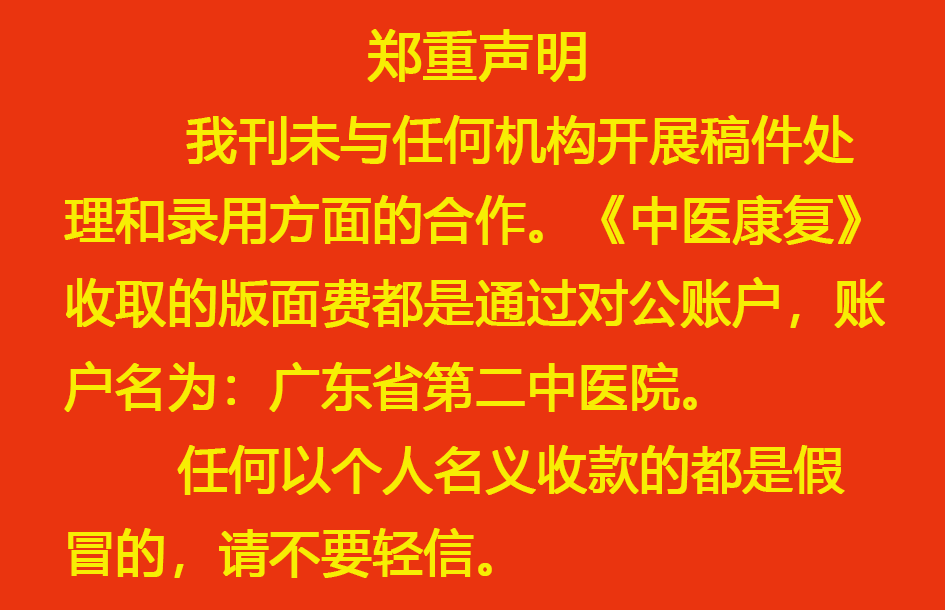| 摘要: |
| 目的:使用三维运动分析系统观察不同严重程度的膝骨关节炎(Knee Osteoarthritis, KOA)恐动症(低KOA恐动症、 高KOA恐动症)患者与年龄匹配的无KOA症状人群在登梯过程中姿势稳定性和下肢关节角度的差异。方法:运用三维运动 分析系统检测低KOA恐动症患者、高KOA恐动症患者和无KOA症状人群共 78例受试者在登梯过程中的姿势稳定性(Mar‐ gin of Stability, MoS)和关节角度等生物力学因素的差异。结果:低、高KOA恐动症患者在登梯过程中在矢状面和冠状面MoS 较差,上梯时髋屈曲和内收最大角度及膝屈伸活动范围均增加;低KOA恐动症患者踝背屈和膝屈曲最大角度均减小;低KOA 恐动症患者膝屈曲最大角度低于高KOA恐动症患者。下梯时,低、高KOA恐动症患者髋屈曲最大角度增加,低KOA恐动症 患者踝内外翻活动范围增加,高KOA恐动症患者髋内收最大角度增加。结论:低、高KOA恐动症患者在登梯时矢状面和冠状 面稳定性较差,但未发现恐动症对KOA患者的显著影响。 |
| 关键词: 膝骨关节炎 恐动症 登梯 姿势稳定性 关节角度 生物力学 |
| DOI:10. 19787/j.issn.2097-3128.2024.01.001 |
| 投稿时间:2023-04-17修订日期:2023-05-19 |
| 基金项目:国家自然科学基金项目,编号:82074515;福建省自然科学基金项目,编号:2020Y0053 |
|
| Effects of Kinesiophobia on Postural Stability of Patients with Knee Osteoarthritis Based on Biomechanics |
| CHEN Yong-kang1, XIE Xue-rong2, WANG Xiang-bin1,2,3 △ |
| (1.Rehabilitation Medicine School offujian university of traditional chinese medicine,fuzhou,fujian 350122;2.the third affiliated people's hospital offujian university of traditional chinese medicine,fuzhou,fujian 350122;3.key laboratory of traditional chinese medicine bone injury and sports rehabilitation, ministry of education,fuzhou,fujian 350122) |
| Abstract: |
| Objective: To observe the difference in postural stability and lower limb joint angle between patients with different severity of Knee Osteo‐ arthritis (KOA, low KOA kinesiophobia and high KOA kinesiophobia) and age-matched non-KOA symptomatic patients during stairs negotiation by using three-dimensional motion analysis system. Methods: Three-dimensional motion analysis system was used to detect the differences of biome‐ chanical factors such as postural stability (MoS) and joint angle among 78 patients with low KOA kinesiophobia, high KOA kinesiophobia and non- KOA symptoms during stairs negotiation. Results: The sagittal and coronal MoS of patients with low and high KOA kinesiophobia were worse than those of asymptomatic people. Compared with asymptomatic people, the maximum angle of hip flexion, maximum angle of hip adduction and range of knee flexion and extension in patients with low and high KOA kinesiophobia increased. Maximum angle of ankle dorsiflexion and maximum angle of knee flexion in patients with low KOA kinesiophobia decreased; the maximum angle of knee flexion decreased in patients with low KOA ki‐ nesiophobia. Compared with asymptomatic people, the maximum angle of hip flexion increased in low and high KOA kinesiophobia patients, the range of motion of ankle varus increased in low KOA kinesiophobia patients, and the maximum angle of hip adduction increased in high KOA kine‐ siophobia patients. Conclusion: The sagittal and coronal stability of KOA patients with low and high KOA is poor, but no significant effect of KOA patients is found. |
| Key words: knee osteoarthritis kinesiophobia stair negotiation posture stability joint angle biomechanics |
